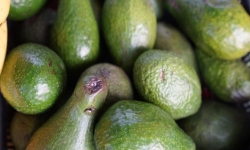Tshwane wastes over 5 000 tons of fresh food every year, study finds
South Africa needs to minimise food waste and ensure that more South Africans have access to food and opportunities in the food supply chain. CSIR researchers have undertaken a study to quantify the food waste at the Tshwane Fresh Produce Market, part of a bigger national effort to quantify food waste.
In December, watermelons flock to Gauteng supermarket shelves like Gauteng citizens flock to the coast. With fewer people inland to eat them, it's just a quick stop at the shop for the giant pink and green berries before they arrive at the landfill. “The peak of the food waste period at the Tshwane market is in summer, when many of us are on holiday at the beach,” says Dr Suzan Oelofse, an expert in waste management at the CSIR. Her team recently investigated food losses at the Tshwane Fresh Produce Market (TFPM), and on the small-scale farms that supply it. “The most wasted items are leafy vegetables like lettuce and spinach, which wilt quickly and soft fruit, like tomatoes, that bruise easily. People don’t want to buy anything that doesn’t look perfect,” says Oelofse. Just at TFPM, more than 5 000 tons of fresh produce goes to waste every year. That weighs about the same as 10 Boeing 747 aeroplanes. The TFPM study forms part of a bigger national effort to define how much food is wasted along the entire value chain from farm to table, across South Africa. Oelofse says, so far, the picture looks very similar for other major fresh produce markets throughout the country. The ultimate aim of these studies is to minimise food waste and ensure that more South Africans have access to food and opportunities in the food supply chain. “We don’t have to produce more food to feed hungry people, we just have to distribute available food, more effectively.”
The turnaround time of fresh food at the market is relatively short, to create space for new fresh deliveries. During harvesting season, crops are harvested daily and sent to the markets. The result is that food that is often still perfectly fine to eat but wasn’t sold within the allowed timeframe, is either sent back to the farm or condemned to landfill. The food that is sent back to the farm is repurposed as animal feed or compost. Since the market is just a middleman, the farmer only receives money for produce that is sold. In addition, oversupply of a specific commodity lowers the price per item, which in turn lowers the income potential of the farmer. As part of the study, Oelofse’s team analysed available data from the TFPM, and interviewed its manager. “What really struck me,” she says, “was a conversation with the manager about a meeting he’d had with 250 of their small farmer suppliers. When he’d asked them, ‘who produces tomatoes?’, nearly every farmer put their hand up. “He then asked them ‘why?’, and they said it's because everyone else does and there’s always a market.” Yet, we know from the data that tomatoes are one of the most wasted items. So, Oelofse says better coordination between farmers and consumer demand would reduce waste and boost income for small farmers. That is one of the recommendations she thinks will assist decision-makers in government. Specifically, the Departments of Forestry, Fisheries and the Environment, Agriculture, Land Reform and Rural Development, and Social Development. She says there may even be room for a central body to assist with coordination of production to better match demand of various food items, and that there are ways to balance small- and large-scale farming in a manner that is financially viable for the entire industry. “One farmer we interviewed for the study said patty pans harvested on Mondays are too big to meet supermarket standards. They harvest six days a week, from Monday to Saturday. Not harvesting on Sunday results in larger items being harvested on Mondays due to fast growth rates. These oversized veggies are often simply donated to charities,” says Oelofse. While this situation may leave the average consumer feeling powerless, Oelofse says we can all do something to waste less food. For example ‘best before’ does not mean ‘bad after’, she says.
“Consumers need to know that those kinds of labels have nothing to do with food safety. ‘Sell by’ dates contain information for retailers, not consumers; they are all about ensuring that today’s harvest will have space on the shelves tomorrow. All food is still good after the ‘sell by’ date. Expiry dates indicated as ‘use-by’ is the only date label that is aimed at the consumer.” Oelofse says she also makes an effort in her own household to use produce that is bruised but otherwise safe to eat, rather than throwing it away. Her reluctance to waste good food is partly informed by her own research, but also spurred by the memory of a terrible stench in her childhood neighbourhood one summer. Local newspapers eventually reported the source – it turns out nothing quite stinks up a dump like a limp watermelon.



